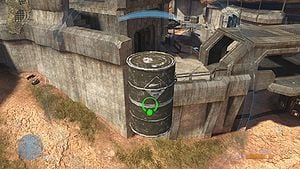Forge was a new way of playing Halo multiplayer pioneered in Halo 3.
Gameplay
Object manipulation
In addition to modifying object spawn locations, Forge can also be used to change the properties of individual objects as well as different types of objects. Pressing X over an item allows a player in Edit Mode to alter that item's settings. Pressing X again allows players to view the settings for all objects of that type. Per-type settings can also be accessed by highlighting the given object's entry in the spawn menus, and then pressing X. An individual object (e.g., a single Gravity Lift) may have its Respawn Rate (which determines how often it spawns) and its Place at Start settings altered. Types of objects (e.g., all Gravity Lifts) may have their Run-Time Minimum and Run-Time Maximum settings altered, which allows mapmakers to ensure that there is always less than or more than a certain amount of a given item during gameplay.
Restrictions
There are some limits when placing items in Forge. The most obvious limit is the set of items permitted in a map—specific items are only allowed in specific maps. As an example, Hornets and Scorpions cannot be placed in The Pit, and Deployable Covers may not be placed in Sandtrap. (The technical explanation is that the tags for certain objects are only present in certain maps. Bungie likely did not place them for balance issues.) There are also varying limits on how many of each item can be placed; while the player can usually place up to thirty-two Frag Grenades, the player can only place two Scorpions when they are available on a map.
The amount of items the player can place in Forge is also regulated by an economy budget system.[1] Different objects are assigned to different values. This is to keep the player from overloading maps and using excessive amounts of memory. Deleting items that are already on the map will free up more money for other items. The spending limit is merely a counter to help the player gauge how much they can place on the map at a given time; no real currency is used. The highest encountered budget is located on the map Sandtrap, with a grand total of 10,000 credits. However using the budget glitch, the player can go beyond the limit set, to do this make the run time maximum one more than the current amount placed on map.[2] or they can download canvases with the budget glitch already in.
All maps have a maximum limit of 640 items.[3] The 640-item limit behaves somewhat oddly; removing items that are in the map by default does not free up more of the 640 "slots", so when editing large maps like Sandbox, it is best to move all default items to the side instead of deleting them and trying to replace them when they need them later.
Furthermore, Campaign objects, enemies, friendlies and “bots” cannot be added to map variants, and the basic geometry of the map cannot be altered.[4]
Forge filters
- Main article: Forge Filters
Forge Filters, referred to in-game as FX, are objects listed in scenery which came in the Legendary Map Pack maps, Cold Storage, and the Mythic Map Pack that change the camera settings. All the filters are as follows:
- Juicy - Everything is bright, vivid and colorful. Saturation is increased.
- Colorblind - Everything is displayed in grayscale.
- Gloomy - Everything is dark, shady, and somewhat desaturated.
- Nova - Everything is extremely bright and blurry, though really dark shadows look quite sharp.
- Old Timey - Everything looks like an old Western movie—the contents of the screen are displayed in sepia tones and are even given a flickering effect, making the screen resemble an old film projector.
- Ink - Scenes are displayed as if they were drawn using an inkpen. Bright areas tend to look more like a grayscale version of the Nova filter.
Bungie has stated that the filters were added for better experiences in gameplay, making interesting screenshots, and for making machinima. The Juicy filter helps with seeing through the Energy Blockers, as does the Old Timey filter. Should more than one of these filters be spawned at one time, the effects will merge to create an entirely new effect. Combining all of the effects reduces visibility to the point where it is improbable to see.
Changes for Halo: The Master Chief Collection
Like the Forge mode featured in Halo: Reach, the Halo 3 Forge component will be updated as part of the addition of Halo 3 to the PC release of Halo: The Master Chief Collection. The updated Forge mode will include the addition of several new props and vehicles to maps that previously did not support them, some previously campaign-exclusive. The maps Foundry, Avalanche and Sandbox have been given the "Thorage" treatment, though all maps have been updated to include weapons previously not useable on them in prior Halo 3 versions.
Notably, these changes provide the first time players are able to Drive an AA Wraith legitimately in the Halo 3 experience without the use of glitches. Additionally, this marks the first time the Elephant has ever been useable outside of the map Sandtrap and the first time the Troop Transport Warthog has been available in multiplayer through legitimate means.[5] Despite the Elephant's now-forgeable status, the Sandtrap map has not been updated to support this functionality, and as a result the Elephant cannot be moved or spawned on Sandtrap.
Outside of item spawns, Halo 3's forge has also been updated with new controls, bringing the mode up to par with the improvements seen in Forge 2.0. Primarily, the controls for forge now have the monitor "orbit" the object, as in Reach etc - making for easier manipulation of objects. Halo 3 forge has also been updated with "fixed" and "phased" physics settings for objects, and coordinate-based manipulation.
Implemented objects
Vehicles
|
Props
|

